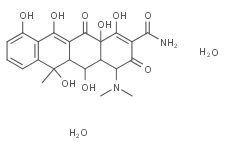
Oxytetracycline Dihydrate
CAS No. 6153-64-6
Oxytetracycline Dihydrate( —— )
Catalog No. M18905 CAS No. 6153-64-6
Oxytetracycline Dihydrate is a prescription antibiotic, interfering with the ability of bacteria to produce essential proteins.
Purity : >98% (HPLC)
 COA
COA
 Datasheet
Datasheet
 HNMR
HNMR
 HPLC
HPLC
 MSDS
MSDS
 Handing Instructions
Handing Instructions
| Size | Price / USD | Stock | Quantity |
| 25MG | 45 | Get Quote |


|
| 50MG | 59 | Get Quote |


|
| 100MG | 106 | Get Quote |


|
| 200MG | 177 | Get Quote |


|
| 500MG | Get Quote | Get Quote |


|
| 1G | Get Quote | Get Quote |


|
Biological Information
-
Product NameOxytetracycline Dihydrate
-
NoteResearch use only, not for human use.
-
Brief DescriptionOxytetracycline Dihydrate is a prescription antibiotic, interfering with the ability of bacteria to produce essential proteins.
-
DescriptionOxytetracycline Dihydrate is a prescription antibiotic, interfering with the ability of bacteria to produce essential proteins.(In Vitro):Oxytetracycline is an important member of the bacterial aromatic polyketide family, which is a structurally diverse class of natural products. Oxytetracycline is synthesized by a type II polyketide synthase that generates the poly-beta-ketone backbone through successive decarboxylative condensation of malonyl-CoA extender units, followed by modifications by cyclases, oxygenases, transferases, and additional tailoring enzymes.(In Vivo):The effects of administration a therapeutic dose of Oxytetracycline (82.8 mg/kg of bw to 1 % bw/day) for 10 days are species specific. Oxytetracycline increases the relative liver weight in Morone chrysops x M. saxatilis, the enzymatic activity of CYP3A4 in Ictalurus punctatus, protein expression of CYP3A4 in Oreochromis niloticus and depleted the hepatic CYP3A4 in the latter.For Oxytetracycline, the limits are 100 μg/kg in muscle and milk, 200 μg/kg in egg, 300 μg/kg in liver and 600 μg/kg in kidney. Oxytetracycline (OTC) is administered to fish as medicated feed at concentrations ranging from 35 to 75 mg a.i kg-1 biomass day-1 for 7-14 days.
-
In VitroOxytetracycline is an important member of the bacterial aromatic polyketide family, which is a structurally diverse class of natural products. Oxytetracycline is synthesized by a type II polyketide synthase that generates the poly-beta-ketone backbone through successive decarboxylative condensation of malonyl-CoA extender units, followed by modifications by cyclases, oxygenases, transferases, and additional tailoring enzymes.
-
In VivoThe effects of administration a therapeutic dose of Oxytetracycline (82.8 mg/kg of bw to 1 % bw/day) for 10 days are species specific. Oxytetracycline increases the relative liver weight in Morone chrysops x M. saxatilis, the enzymatic activity of CYP3A4 in Ictalurus punctatus, protein expression of CYP3A4 in Oreochromis niloticus and depleted the hepatic CYP3A4 in the latter.For Oxytetracycline, the limits are 100 μg/kg in muscle and milk, 200 μg/kg in egg, 300 μg/kg in liver and 600 μg/kg in kidney. Oxytetracycline (OTC) is administered to fish as medicated feed at concentrations ranging from 35 to 75 mg a.i kg-1 biomass day-1 for 7-14 days.
-
Synonyms——
-
PathwayOthers
-
TargetOther Targets
-
RecptorOthers
-
Research AreaOthers-Field
-
Indication——
Chemical Information
-
CAS Number6153-64-6
-
Formula Weight496.46
-
Molecular FormulaC22H24N2O9·2H2O
-
Purity>98% (HPLC)
-
Solubility——
-
SMILESO.O.[H][C@@]12[C@@H](O)[C@@]3([H])C(C(=O)C4=C(O)C=CC=C4[C@@]3(C)O)=C(O)[C@]1(O)C(=O)C(C(N)=O)=C(O)[C@H]2N(C)C
-
Chemical Name——
Shipping & Storage Information
-
Storage(-20℃)
-
ShippingWith Ice Pack
-
Stability≥ 2 years
Reference
1.Li Y, Wang H, Liu X, Zhao G, Sun Y.Environ Sci Pollut Res Int. 2016 Apr 13.
molnova catalog



related products
-
Fondaparinux sodium
Fondaparinux Sodium is an antithrombin-dependent factor Xa inhibitor with antithrombotic activity.
-
KN-93 Phosphate
KN-93 Phosphate is a potent and specific CaMKII inhibitor (Ki: 0.37 μM), no inhibitory for PKC, APK, MLCK or Ca2+-PDE activities.
-
Glychionide A
Glychionide A is a natural product.



 Cart
Cart
 sales@molnova.com
sales@molnova.com


